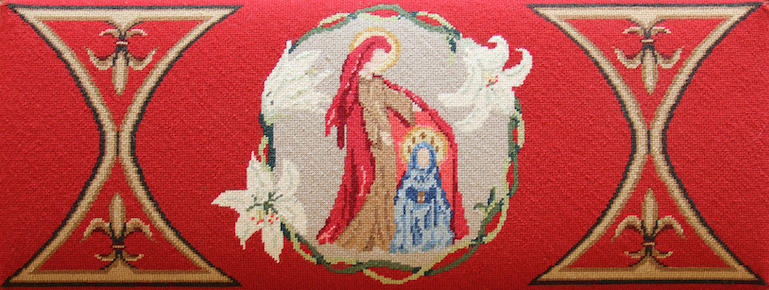Return to Needlepoint Collection

- Patron: Donna Johnson
- Initial stitcher: Marge Speich
- Finishing stitchers: Carla Ballew and Darlene Pilcher
- With prayers for all children who find learning to read difficult, and for those who teach them
St. Anne, Mother of Mary
This original design depicts our patron saint, St. Anne, sheltering her daughter Mary as the child reads, a traditional depiction of the two. The lilies represent Mary’s innocence and purity. Although the piece was originally designed as the central cushion for the Communion rail, it was moved to the acolyte servers’ station after a renovation to the rail eliminated the gates for the sake of handicap accessibility. Among its other uses, this cushion is used by confirmands at St. Anne’s when they kneel before the Bishop for Confirmation.
The Gospels tell us little about the home of our Lord’s mother Mary. She is thought to have been of Davidic descent and to have been brought up in a devout Jewish family that cherished the hope of Israel for the coming kingdom of God, in remembrance of the promise to Abraham and the forefathers.
In the second century, a devout Christian sought to supply a fuller account of Mary’s birth and family, to satisfy the interest and curiosity of believers. An apocryphal gospel, known as the Protevangelium of James or The Nativity of Mary, appeared. It included legendary stories of Mary’s parents Joachim and Anne. These stories were built out of Old Testament narratives of the births of Isaac and of Samuel (whose mother’s name, Hannah, is the original form of Anne), and from traditions of the birth of John the Baptist. In these stories, Joachim and Anne — the childless, elderly couple who grieved that they would have no posterity — were rewarded with the birth of a girl whom they dedicated in infancy to the service of God under the tutelage of the temple priests.
In 550 the Emperor Justinian the First erected in Constantinople the first church to Saint Anne. The Eastern Churches observe her festival on July 25. Not until the twelfth century did her feast become known in the West. Pope Urban the Sixth fixed her day, in 1378, to follow the feast of Saint James. Joachim has had several dates assigned to his memory; but the new Roman Calendar of 1969 joins his festival to that of Anne on July 26.
From Lesser Feasts and Fasts 2003
